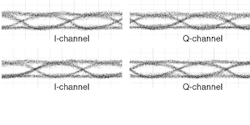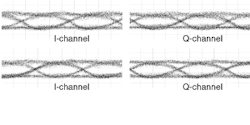Techniques combine for high data rates
A research team led by Stuart Walker at the University of Essex (Colchester, England) has developed a data-transmission technique that the group claims can achieve world-record telecommunications data rates on standard multimode fibers (MMFs). In preliminary experiments, a data rate of 1.02 Tbit/s was shown to be feasible over a distance of up to 3 km. This technique could save telecommunications companies money by allowing them to increase the data traffic on their existing networks without laying new and more expensive fiber.
Data transfer requirements of local-area networks are steadily increasing. The majority of the existing "within-building" links use MMF, with typical link lengths around 300 m. Metro links will require significantly greater distances, however—perhaps up to several kilometers—while maintaining a bandwidth of many gigabits per second. The now-standardized Gigabit Ethernet rate leads to transmission of 1.25 Gbit/s over 0.55 km of MMF with long-wavelength (1300-nm) laser sources, and over 0.275 km at 850 nm.
null
To achieve higher transmission rates over greater lengths requires techniques that can overcome both bandwidth and noise limitation problems. Wavelength-division-multiplexing (WDM) techniques and multilevel coding give improvements in the bandwidth-distance product of MMF links. Subcarrier multiplexing (SCM) has recently been used in MMF links to transmit data at rates beyond the conventional bandwidth limits. In this technique, subcarrier sidebands are put on each optical signal, the maximum number of these being determined by the separation of the signals in the optical domain. Subcarrier multiplexing takes advantage of relatively flat regions of the fiber response outside its modal bandwidth range by transmitting several narrowband channels in the passband region of the fiber, instead of a single broadband channel in its baseband.
Baseband information signals in a SCM system modulate different subcarriers at high frequencies using a standard digital modulation scheme. Only the desired narrowband channels have to be demodulated in the receiver, resulting in an increase in the receiver sensitivity, leading to higher data rates. Previous complete system experiments with SCM have demonstrated the transmission of 1-Gbit/s channels and a single 2.5-Gbit/s channel over 500 and 300 m of MMF respectively.
Two kinds of multiplexing
The Essex team has developed a combination of SCM and high-density WDM techniques to provide ultrahigh data rates over conventional 50-µm graded-index MMF links of up to 3 km. This system uses 20-GHz-spaced high-density WDM with two 2.55-Gbit/s electrical SCM data channels, one in-phase and one in quadrature (I&Q), at each wavelength.
In the experimental setup a 90° hybrid splits the 5.1-GHz subcarrier into input-and-output signals, and two data channels are used to modulate each of these quadrature subcarriers. Two 2.55-Gbit/s input and output data channels on a 5.1-GHz subcarrier allow an aggregate of 5.1 Gbit/s for each HDWDM channel.
One new feature in this system is the re-injection of the 5.1-GHz carrier signal at the point where the quadrature signals are combined. This provides a pilot tone for use at the receiving end. The data is synchronized to the carrier to avoid skew problems in the HDWDM system. After broadband amplification, the composite signal is passed to a 12-GHz-bandwidth Mach-Zehnder (MZ) modulator, which simultaneously controls the intensities of up to 10 representative frequency-stabilized lasers and additional wavelength-tunable channels. This allows the group to study HDWDM channel spacings down to 6 GHz.
The single-mode MZ output is launched into MMF spans ranging from 300 m to 3 km. At the receiver end, each of the possible channels is wavelength-selected using an electronically tuned monochromator. The receiver consists of a three-way splitter, which divides the signal between the 5.1-GHz carrier-recovery phase-locked loop for reference and synchronization, and the two arms of the input-and-output demodulator. The demodulated I&Q signals are passed to two data receivers.
Reaching terabit rates
In the initial experiments at Essex, both 10 simultaneous and two selected individual wavelengths (around 1558 nm) have been used (see figure). These have 20-GHz wavelength spacing, with each wavelength carrying 5.1-Gbit/s data on a 5.1-GHz subcarrier. They are combined in a 40-channel 100-GHz arrayed-waveguide grating and transmitted over 3 km of 50-µm-core-diameter MMF. Adjacent channel interference effects are not discernable. This leads the group to conclude that it is possible to build and operate a fully populated 200-channel laser array, which would be expected to allow a total data rate of 1.02 Tbit/s.
The group also notes that the low modal bandwidth (about 500 MHz-km) of the fiber used prevents good-quality baseband transmission at 2.5 Gbit/s. In contrast, an aggregate of 5.1-Gbit/s (I&Q channels) can be transmitted on the 5.1-GHz subcarrier per wavelength channel. Because each wavelength channel exhibits modulation sidebands centered at 5.1 GHz on either side of the optical carrier, a wavelength spacing of less than 20 GHz is theoretically possible. The latest generation ultra-narrowband filters will allow spacings of 10 GHz and below. Walker believes the technique will have an important role to play in upgrading legacy MMF fiber networks.

